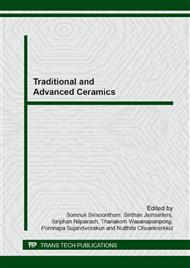p.187
p.193
p.200
p.206
p.212
p.218
p.224
p.230
p.235
Anodic Oxide Film Formed on Ti-6Al-4V at a Low Current Density in Monocalciumphosphate Monohydrate (MCPM) Electrolyte and its Biocompatibility
Abstract:
Anodic oxide film on titanium alloy (Ti-6Al-4V) substrate was prepared by anodization. The reaction was done by applying low current densities from 0.25 to 2 mA/cm2 for 30 minutes using monocalciumphosphate monohydrate (MCPM) solution as an electrolyte. Essential parameters which affected to the formation of anodic oxide film were studied. The properties of the anodic oxide film would be optimized when the parameters were appropriately controlled. Increasing of the current density and the concentration of MCPM electrolyte could promote hydrophilicity and surface roughness of the film. After anodization, the anodic oxide film formed at 2 mA/cm2 in 1M MCPM showed the best hydrophilicity (lowest water contact angle) and the film formed at 0.25 mA/cm2 in 0.5M MCPM showed the lowest hydrophilicity (highest water contact angle). XPS analyses confirmed that the chemical species of as-anodized film formed at 2 mA/cm2 in 1M MCPM changed. Ti2p spectra scarcely changed while the O1s spectra significantly changed due to the presence of chemisorbed water and Ti-OH formed during anodization. The SEM micrographs also revealed the biocompatibility from the growth of the cementoblast cell on anodized surface. It was indicated that anodization using MCPM as an electrolyte at 2 mA/cm2 in 1M MCPM could modify the surface roughness and chemical species and that both are likely to be crucial key factors for enhancing of hydrophilicity of as-anodized film which would enhance the biocompatibility of Ti-6Al-4V as a result.
Info:
Periodical:
Pages:
212-217
Citation:
Online since:
April 2014
Keywords:
Price:
Сopyright:
© 2014 Trans Tech Publications Ltd. All Rights Reserved
Share:
Citation:


